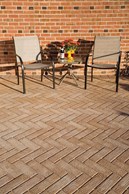Timeless features make a home distinctive. The brickwork pattern for your outdoor walkways or driveways is a place to express the home’s unique character. While there are many layouts and pavers to choose from, the classic herringbone pattern stands the test of time. It looks equally impressive in walkways, patios and driveways.

According to lifestyle watchers at Hello Magazine, the searches for “herringbone” on Pinterest has increased by 131 percentage points. A big jump like that indicates an upswing for the pavers and brickwork pattern, but herringbone is far from a trend. Herringbone is one of those ancient and classic patterns that will never go out of style. It’s beauty and practicality have transcended thousands of years.


Egyptians made the first stone roads using quarried rocks. As masonry and stonework methods progressed, uniformly-sized bricks became popular for road construction. Later, the Romans, who were known for their brickwork patterns developed the opus spicatum, meaning “spiked work.” We know this pattern as herringbone. The term “herringbone” was an English term based on the spinal structure of the most common Atlantic fish of the same name.

No need to ask your landscape architect if herringbone is strong enough for the driveway. The opus spicatum pattern turned out to be a major advancement. Herringbone cross-hatching makes for an extremely sturdy surface. The more weight the herringbone surface bore on those ancient Roman roads, the stronger those roads became. Some have lasted thousands of years and can still be traveled today.

The texture of the pattern is a nice draw for the eye, especially in large spaces like driveways. If a driveway or walkway is a prominent piece of the curb appeal, a pattern of brickwork inspires curiosity and interest more than a large swath of dark asphalt or white concrete. Pavers in a herringbone pattern match very well with brick homes, as the typical horizontal brickwork pattern complements the diagonal lines of the opus spicatum.


Herringbone patterns don’t require only red bricks. Any rectangular paver can be set in a crosshatch. A herringbone pattern can be laid in either a 45 degree or 90 degree angle. Check out any previous work your contractor has completed. Gather image board pictures. Don’t limit your imagination to only what’s been done before. This ancient technique always stays relevant, and adding it to your driveway, walkways or patio will be an enhancement to last a lifetime.